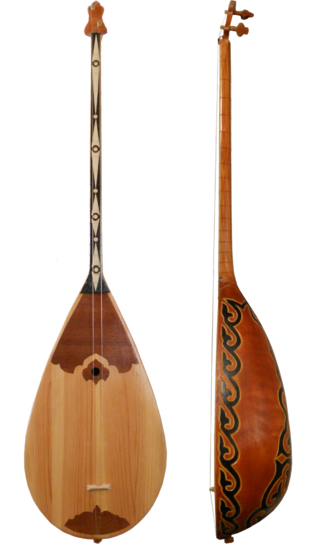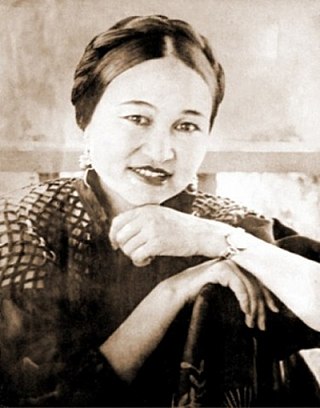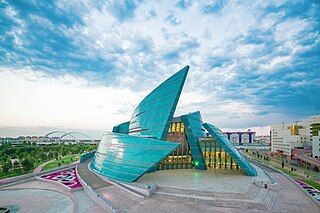
Almaty, formerly known as Alma-Ata, is the largest city in Kazakhstan, with a population of over two million. It was the capital of Kazakhstan from 1929 to 1936, while the country was an autonomous republic of the Soviet Union, then from 1936 to 1991, a union republic and finally from 1991, an independent state. In 1997, the government relocated the capital to Akmola.

The Dombra, also known as Dombyra, is a long-necked musical string instrument used by the Kazakhs, Hazaras, Uzbeks, Tajiks, Nogais, Bashkirs, and Tatars in their traditional folk music. The Dombura shares certain characteristics with the komuz and dutar instruments, such as its long, thin neck and oblong body shape. It is a popular instrument mostly among Turkic communities in Central Asian countries.
Music of Kazakhstan refers to a wide range of musical styles and genres deriving from Kazakhstan. Kazakhstan is home to the Kazakh State Kurmangazy Orchestra of Folk Instruments, the Kazakh State Philharmonic Orchestra, the Kazakh National Opera and the Kazakh State Chamber Orchestra. The folk instrument orchestra was named after Kurmangazy Sagyrbayuly, a well-known composer and dombra player from the 19th century.

Kulyash Jasynqyzy Baiseitova was a Soviet and Kazakh opera singer and actress. People's Artist of the USSR (1936).

A jüz is one of the three main territorial and tribal divisions in the Kypchak Plain area that covers much of the contemporary Kazakhstan. It represents the main tribal division within the ethnic group of the Kazakhs.
Yuri Alexeyevich Zuev or Zuyev was a Russian-born Kazakh sinologist and turkologist.
Quddus Khojamyarov was a Uyghur Soviet composer from Kazakhstan. He was named a People's Artist of the USSR.

The Ykhlas Museum of Folk Musical Instruments is a musical instrument museum located in Almaty, Kazakhstan.

Yevgeny Grigoryevich Brusilovsky was a Soviet and Russian composer who settled in Kazakhstan. He wrote the first Kazakh opera, co-wrote the music for the anthem of the Kazakh Soviet Socialist Republic, and was a People's Artist of the Kazakh SSR.

Cinema of Kazakhstan refers to the film industry based in Kazakhstan. Cinema in Kazakhstan can be traced back to the early 20th century. Today, Kazakhstan produces approximately fifteen full-length films each year.
Dina Nurpeisova or Nurpeissova was a composer from the western part of Kazakhstan in the Uralsk area. She was also a noted dombyra player. For her musical accomplishments, she was recognized as the National Artist of Kazakhstan. An orchestra, the Academic Folk Orchestra of Dina Nurpeisova, is named after her, as well as a small village, Dina Nurpeisova. On the 150th anniversary of her birth, in 2011, a postage stamp was issued to commemorate her.

The 28 Panfilov Guardsmen Park is an urban park located in east-central Almaty in the area surrounding the Ascension Cathedral. It is dedicated to and named after the Panfilov heroes which were the 28 soldiers of an Alma-Ata Infantry unit who allegedly died while defending Moscow from the German invasion during the Second World War. The group took its name from Ivan Panfilov, the General commanding the 316th division which, in spite of heavy casualties, believed at that time managed to significantly delay the Germans advance to Moscow, thus buying the time for the defenders of the city. An eternal flame commemorating the fallen of the World War II and the Eastern Front burns in front of the giant black monument of soldiers from all 15 Soviet Republics.

Maria Egorovna Rykina, pen-named Mariyam Zhagorkyzy (1887—1950), was an author and performer of Kazakh folk songs, and a People's Artist of the Kazakh SSR (1945).

The art of Kazakhstan covers all forms of art created throughout history by the peoples living on the territory of modern-day Kazakhstan. Throughout most periods, much of the population of Kazakhstan was nomadic, or at least moved regularly across the vast country. The great majority of the art of Kazakhstan is applied art: the decoration of practical objects, including household utensils and patterned harnesses, through art forms such as carpet-weaving, pottery, and leatherwork. The art of Kazakhstan also includes architecture, fine arts, and sculpture.

Bibigul Akhmetkyzy Tulegenova is a Soviet-Kazakh opera singer, actress and teacher. Among her awards are Hero of Socialist Labor (1991), People's Artist of the USSR (1967), and the USSR State Prize (1970).

Aqtoty Rahmetollaqyzy Raiymqulova is a Kazakh politician who's serving as a Minister of Culture and Sports, Director of the State Enterprise State Concert Organization "Kazakhconcert named after Roza Baglanova"
The Kurmangazy Kazakh National Conservatory is a high musical institution in Kazakhstan which trains composers, musicologists, conductors of the choir and folk orchestras, pianists, vocalists, art managers, performers on all instruments of the symphony orchestra and folk instruments.
The Jambyl Kazakh State Academic Philharmonic is a creative association created on 14 January 1935 by the Decree of the Council of People's Commissars of the Kazakh SSR. It was originally organized by the Kazakh musicologist Akhmet Zhubanov as a regional art and concert organization. Since 1938, it bears the name of the famous Kazakh akyn Zhambyl Zhabayuly.

The State Concert Organization "Kazakhconcert" of the Ministry of Culture and Sports is the largest musical organization in Kazakhstan.

Kara Jorga or Kara Zhorga is a traditional Kazakh instrumental song (küy) and dance depicting a horse that uses an ambling gait. Along with other nomadic dances, the Kara Zhorga dance connected to animalistic symbolism and Tengrianism. The dance can be performed with other instrumental songs (küy), however, Kara Jorga became most popular among Kazakh and then Kyrgyz people. Similar dance moves are also native to Mongolian people.
From the National Library of the Republic of Kazakhstan. Books in Russian.
1. Akishev K.A. "Kurgan of Issyk". — Moscow, 1978.
2. Alekseeva L. А., Nazhmedenov Zh. "Uniqueness of the Kazakh dombyra sound and tuning//Kazakh Culture:researches. Scientific articles brochure, Almaty, 2000.
3. Alekseeva L. А., Nazhmedenov Zh. Features of Kazakh Dombyra.// My i vselennaya journal. 2001.No. 1(6), p52-54.
4. Amanov B. Terms of compositions for dombyra Kui. Alma-Ata, 1982.
5. Aravin P.V. Steppe's stars. — Alma-ata, 1979.
6. Aravin P.V. Great Kuishi Dauletkerei.-Alma-ata, 1964.
7. Asafjef B.V. About Kazakh folk music.//Musical culture of Kazakhstan.-Alma-Ata, 1955.
8. Baramankulov M. Turkic space.-Almaty, 1996.
9. Vyzgo T. Musical instrumentsof the Central Asia.-Moscow, 1980.
10. Gizatov B.. Social and esthetic basics of Kazakh folk instrumental music.-Alma-Ata, 1989.
11. Zhubanov A.K. Dombyra-Kazakh national instrument.//Muzykoznanie journal.-Alma-Ata, 1976. p. 8-10.
12. Stakhov V. Arts od violin master. — Leningrad, 1988.
13. Nazhmedenov Zh. Acoustic features of Kazakh Dombyra. Aktobe, 2003.
14. Utegalieva S.I. Dombyra tradition in Mangystau. Almaty, 1997.













